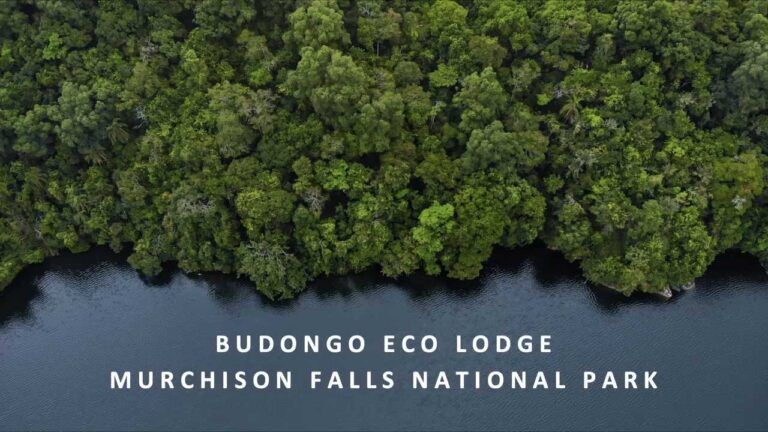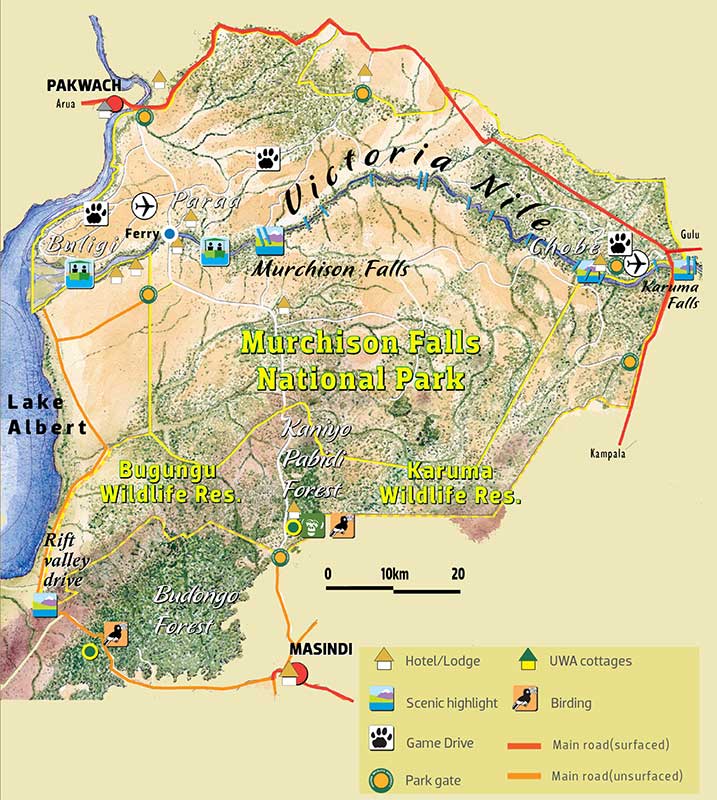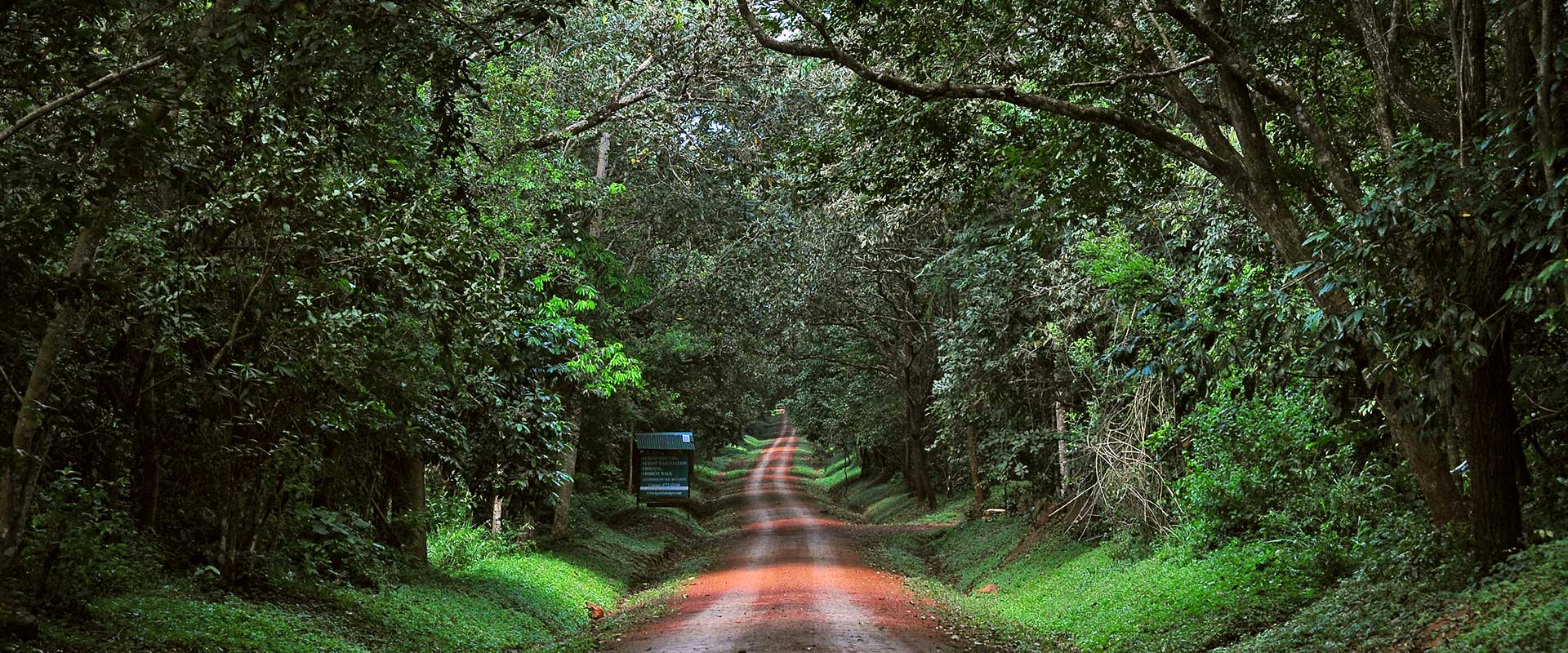 BUDONGO ECO LODGE
BUDONGO ECO LODGE BUDONGO ECO LODGE
BUDONGO ECO LODGE BUDONGO ECO LODGE
BUDONGO ECO LODGE BUDONGO ECO LODGE
BUDONGO ECO LODGE BUDONGO ECO LODGE
BUDONGO ECO LODGE BUDONGO ECO LODGE
BUDONGO ECO LODGE MURCHISON FALLS NATIONAL PARK
MURCHISON FALLS NATIONAL PARK BUDONGO ECO LODGE
BUDONGO ECO LODGE
Budongo eco lodge
★★☆☆☆
Murchison Falls National Park
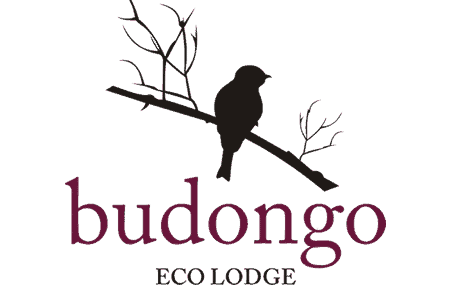
Nestled in the heart of Budongo Central Forest Reserve, within the boundaries of Murchison Falls National Park, Budongo Eco Lodge is one of the undiscovered pearls of Uganda.
Being the habitat of more than 600 chimpanzees and 8 other species of primates, Budongo Forest has one of the largest communities of chimps in the country. It is also home to rare forest bird species, such as the Puvel’s Illadopses, which is endemic to this region. Moreover, Budongo Reserve is the largest remaining Mahogany forest in East Africa, with impressive trees growing up to 80 meters. With a network of 115 km of trails, this unexplored areaoffers you great excitement and adventure!
The Kaniyo Pabidi Eco-tourism site, which was first managed by the Jane Goodall Institute, was taken over in August 2009 and changed its name to Budongo Eco Lodge under the management of Uganda Lodges. Together with the National Forest Authority (NFA) we have made it our task to develop this relatively unknown tourism site and to protect the forest reserve with its unique species of primates, birds and plants.
Budongo Eco Lodge consists of comfortable eco-cabins with private veranda, four spacious dorm rooms, a visitor’s centre and restaurant. In addition, the lodge offers many different activities in the direct surroundings, including chimp tracking, chimpanzee habituation, forest walks and bird watching. The combination of this eco-tourism facility with superb safari accommodation and a wide choice of forest activities provides a wonderful mix of relaxation and adventure, set against the unique backdrop of the untouched African nature…
Video tour Budongo Eco Lodge – Murchison Falls National Park
Lodge
Eco-Cabins
Tucked away in the pristine forest, the five intimate cabins are perfectly blending with the natural environment. They are connected by well maintained walking paths and constructed with traditional materials for a low environmental impact. Each cabin has a private deck that overlooks the surrounding forest and its rich (bird)life. The rooms are spacious and bright, with large twin or double beds and a sitting area. En suite is a fully equipped bathroom with a wash table, shower and separate composting toilet.
Dormitory rooms
For larger groups, Budongo Eco Lodge offers four comfortable dormitory rooms, each with two double-deckers. The bunk beds are provided with a mosquito net. Adjacent to the dormitory rooms is a common shower and toilet block with hot and cold running water.
Restaurant
The restaurant is found in a beautiful natural setting and invites guests to relax and enjoy the sounds of the forest. While getting prepared for your activity, have a cold soda, hot snack or one of our delicious chocolate brownies. Taste our excellent fresh-brewed Ugandan coffee or have dinner in the warm light of the candles at night. The restaurant offers a variety of traditional and international meals that will be served outside on the terrace, while enjoying the magical forest that encloses the lodge.
Visitor’s Centre Budongo Eco Lodge Budongo Eco Lodge also makes a perfect lunch stopover when you are on your way to the northern part of the park, returning to Kampala or visiting the forest for chimp tracking, birding or any of the other activities.
Visitor’s Centre
The main reception area is located in the visitor’s centre. This area, with its large soft couches in a rustic environment, is an ideal place to relax and read a book. The visitor’s centre also displays a selection of different animal skeletons, fossils and snares that were found in the forest, used by poachers. In addition, detailed information about Budongo Forest Reserve and its habitants is provided to help its visitors to interpret the forest’s secrets and understand its complex eco-system.
Craft Shop
Adjacent to the reception area is Budongo’s Craft Shop, offering a small yet excellent selection of Uganda’s crafts and gifts. The products vary from handmade postcards and paper-beaded necklaces to guidebooks, handwoven baskets and papercraft notebooks. The handcrafts are made by local women using natural materials with simple and colourful designs.
Guest Information
Accommodation:
- 5 eco-cabins with private bathroom and veranda
- 4 mixed dormitory rooms, each with 2 double-deckers and shared washing facilities
Facilities:
- Outdoor restaurant
- Visitor’s centre with craft shop
- Lounge area
- Parking available
Check In / Check Out Times
- Check In: 02.00 pm
- Check Out: 10.00 am
Dietary Requirements:
Please inform us in advance about any special dietary requirements and we will do our best to supply this.
Drinking water:
It is not recommendable to drink water from the tap. Bottled mineral water is available for sale at the visitor’s centre, as are sodas, beer, tea and coffee.
What to bring:
- Casual light clothing (T-shirts, shorts, sleeveless blouses, jeans etc.)
- Comfortable hiking shoes
- Long-sleeved sweater or jacket for the cooler evenings and mosquitoes
- Sandals
- Cap/hat
- Sun lotion
- Sunglasses
- Insect repellent
- Torch
- Binoculars
Valuables:
The camp is not responsible for valuables kept in the rooms. Personal items of value can be stored at the reception in the visitor’s centre.
Power supply:
The main lodge and rooms are equipped with solar powered electricity. However, due to the environment, the solar system may not charge as expected. In this case kerosene lanterns are provided at the reception. We kindly request you to use the power in an eco-responsible way and turn off the lights when leaving the room.
Adapters:
Cameras and mobiles can be charged at the reception in the visitor’s centre.
House keeping:
As part of our services, your room will be cleaned every day. For conservation purposes, bed sheets and towels are only changed upon request. If you would like to receive fresh towels, please leave the used ones on the bathroom floor.
Environmental commitment:
We seek to minimize the impact on the environment. Nothing is left in the nature other than our footprints. Nothing is taken from the nature other than memories. Even in a rainforest, water is a precious commodity, so please use water sparingly. We kindly ask you for your support by respecting our valued guidelines.
Community tourism:
The local community is greatly involved in the running of the lodge, including employment, the sale of handcrafts and the provision of fresh vegetables and fruits from their gardens.
Further enquiries:
Feel free to contact us for any additionally required information.
ACTIVITIES
Budongo Forest Reserve is an area with an enormous diversity in flora and fauna. Thanks to the extended and well maintained network of forest trails, it is possible to explore the dense forest with its beautiful biodiversity in different ways.
Enjoy a guided primate walk in the lush expenses of the tropical forest, in search of the habituated chimpanzee family. Your guide will explain you more about the animals and plants species that you encounter on your way. Also look out for other primates like the Black-and-White Colobus Monkeys, Red-tailed Monkeys, different type of birds, tracks of mammals and much more. Chimp tracking can be experienced daily with two viewing times per day. The hike takes about 2 to 4 hours, depending on the movement of the chimpanzees. Once the chimps are found you will stay for one hour with these amazing creatures to watch them eating, resting and playing.
DID YOU KNOW!
Children below the age of 15 can do chimp tracking if their parents agree to sign a consent form to allow them to do the activity.
Video chimpanzee tracking Budongo Eco Lodge
With the Habituation Experience you will spend an entire day with our ‘cousins’ and learn about their way of life. Chimpanzee Habituation in Budongo Forest started in 1992 with the aim to habituate the chimpanzees to human presence, without necessarily altering their natural behaviour. This is a long process and it can take up to 15 years to fully habituate a chimpanzee community. The Habituation Experience offers you the unique experience to join the professional guides on their daily program and follow the chimps during their activities. Since you will be out in the forest from the early morning till the end of the day, a packed lunch can be provided by the lodge.(not available during peak season months July, August and September)
Budongo Forest is truly a paradise for birders with 360 species of birds. Accompanied by a guide you will follow the trails and look out for different types of birds. Bird watching safaris are available for a half or full day and guided by keen birders. If you have more than one day in Budongo then a visit to the ‘Royal Mile’ is a must. It is located about 60 km from Budongo Eco Lodge and offers a spectacular wide forest avenue with a high density of birds, including the Chocolate-backed Kingfisher and Paradise Flycatcher.
Well developed forest trails give you the perfect opportunity to explore the beauty of the tropical rainforest. Learn more about the eco-system, pass the old Mahogany trees and encounter different species of butterflies on your path. As the terrain is flat, the forest walks are suitable for the average tourist.
Since Budongo Forest is located in Murchison Falls National Park you can easily combine your visit to the magical forest with wildlife viewing in the northern part of the national park. Cross the river Nile and follow the winding tracks in search of giraffes, elephants, buffaloes and lions. Thanks to the palm-dotted hills, vast savannah plains and beautiful Delta area this is one of the most scenic and best places for encounters with the wild animals of Uganda. In addition, you can make a boat safari on the Nile or visit the magnificent Murchison Falls to enhance your wildlife experience even more.
SAFARI PACKAGES
Enjoy a guided primate walk in the lush expenses of the tropical forest, in
An amazing 3-days Primate Safari that will give you the opportunity to meet Uganda primates in a unique way! Track deep into the forest in search of the chimpanzee family and spend a full day in their presence. The chimp habituation is a wonderful experience to learn more about the chimp community and discover the features we have in common! Another guided forest walk will enable you to enjoy even more of the pristine African jungle!
The package includes:
- Transport from Kampala (min. 2 people)
- Experienced English speaking driver/guide
- 2 nights in Budongo Eco Lodge in the Eco Cabin based on Half Board
- Full day Chimp Habituation in Budongo Forest Reserve
- Guided Forest Walk in Budongo Forest
With the Habituation Experience you will spend an entire day with our ‘cousins’ and learn about their way of life. Chimpanzee Habituation in Budongo Forest started in 1992 with the aim to habituate the chimpanzees to human presence, without necessarily altering their natural behaviour. This is a long process and it can take up to 15 years to fully habituate a chimpanzee community. The Habituation Experience o
With 360 different species, Budongo is famous for its biodiversity in birds. It is home to the rare Puvel’s Illadopses which is endemic to Budongo Forest. Also a visit to the Royal Mile is included in this unique Birding Safari, one of the best forest birding sites in Uganda! This area hosts a wide variety of birding species such as the African Dwarf and Blue-breasted Kingfisher. Explore this birder’s paradise guided by the most experienced birders.
The birding package includes:
- Private transfer to/from Kampala (min. 2 people)
- 2 nights in Budongo Eco Lodge in the Eco Cabin based on B&B
- Multiple Birding Walks accompanied by experienced birding guides
Experience the best of Murchison Falls National Park in this 4-days Wildlife & Chimp safari! Cross the river Nile for an unforgettable game drive and view wildlife from close quarters during your boat safari. Marvel at the Top of the famous waterfalls and track the chimpanzees in the beautiful forest of Budongo. You will spend two nights in a budget camp surrounded by wildlife and one night in the comfortable dormitory rooms of Budongo Eco Lodge.
The package includes:
- Shared return transport from Kampala (min. 4 people)
- 2 nights in Red Chilli Rest Camp (twin room) based on B&B
- 2 nights in Budongo Eco Lodge in mixed dormitory rooms (with possibility for upgrading)
- Walk at the Top of the Falls
- Game drive and boat safari on the Nile
- Chimp tracking in Budongo Forest Reserve
BUDONGO FOREST
Budongo Central Forest Reserve is the largest survival natural forest in Uganda, with a total surface of approximately 825 square km, of which 430 square km is continuous forest. The reserve sits atop the Albertine Rift, part of the Great Rift Valley, and is located within the boundaries of Murchison Falls National Park.
Budongo Forest Reserve is a medium altitude, moist, semi-deciduous tropical rainforest managed by the National Forestry Authority (NFA). Historically, the forest was protected by the King of Bunyoro and only with his permission could local chiefs hunt inside the forest. Thanks to his strict policy the flora and fauna was preserved, until the reserve was officially gazetted in 1932. The name Budongo derives from the local Bunyoro word ‘fertile soil’.
Budongo offers an extremely rich biodiversity including 24 species of small mammals, 9 species of primates and 280 butterflies. It is also the natural habitat of more than 600 chimpanzees, of which a small community has been habituated for eco-tourism purposes. This family consists of 80 individuals, allowing visitors the unique opportunity to view these amazing apes in their natural environment. Other primates that can be observed are the Black-and-White Colobus Monkeys, Olive Baboons, Red-tailed Monkeys, Blue Monkeys and Grey-cheeked Mangabeys.
A well developed and extensive trail system with a length of 115 km in total is found througout the forest, which enables tourist activities like forest walks, chimp tracking and birding. Apart from the 465 species of plants, the reserve is also famous for the age-old, Mahogany trees which can grow up to 80 meters. Some of the best bird viewing is found in the area known as the Royal Mile, which is part of Budongo Forest Reserve. About 360 species of birds are recorded in the total area, including the rare Puval’s Illadopses which is endemic to the region. Others include the Chocolate-backed Kingfisher, Chestnut Crowned Eremomera, Dusky long-tailed Cuckoo, Yellow-browned Camaroptera, Black-headed Paradise Flycatcher, Slender-billed Greenbul, Lemon-bellied Crombec, Forest Robin, White-spotted Flufftail, Yellow and Grey Longbill, Little Green Sunbird, Western Black-headed Oriole, African Emerald Cuckoo, Yellow-manted Weaver, Crested Malimbe and Cassin’s Hawk Eagle among others.
- District: Masindi
- Elevation: 1110 – 1590 meters
- Size: 825 sq km
- Habitat: Budongo Forest is a medium altitude, moist, semi-decidusou tropical rain forest.
- Status: Forest Reserve since 1932
- Best time to travel: All year round. Thanks to the location on the equator, Uganda has a tropical climate. Rainfall occurs regularly, with a peak in the months of April-May and November.
Budongo Eco Lodge is located in Budongo Central Forest Reserve in Murchison Falls National Park, 30 km north of Masindi town. From the Kichumbayobo Gate follow the main road to Paraa. After 8 km you will see a signpost on your left side, from where you turn right to reach the lodge.
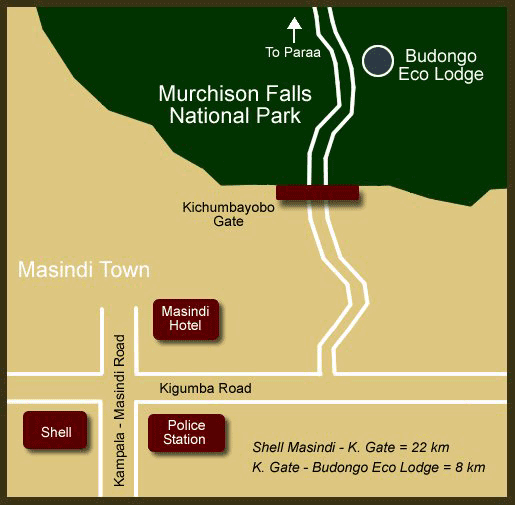
In conjuction with the Jane Goodall Institute, Budongo Eco Lodge was nominated for the Tourism for Tomorrow Conservation Award 2011! Finalists for this award were selected based on the greatest tangible contribution to the preservation of nature, including the protection of wildlife, expanding and restoring natural habitat, and supporting biodiversity conservation.
The survival of this magical forest is the result of years of continuous protection by kings, governments, conservationists and the local people. Nevertheless, the four greatest threats to the unique flora and fauna have been snare hunting, human encroachment, over-collection of forest products and illegal logging. With the revenues from eco-tourism activities such as chimp tracking and bird watching, a number of conservation projects can be supported:
- Conservation Education Programs teach children and local community members about the value of the forest and its wildlife. Programs offer suggestions on how to use the forest wisely.
- Law Enforcement monitors the reserve and prosecutes illegal users of the forest, thus protecting threatened species like chimpanzees and Mahogany trees.
- Community Awards benefit the local people and increase their capacity to protect the natural resources.
Also the foundation of the Budongo Forest Project Field Station in 1990 by Dr Vernon Reynolds, which is located in the middle of Budongo Forest, plays a crucial role in the protection of the reserve. Although the main focus is the conservation and study of the habituated group of chimpanzees, it also carries out many other conservation and research activities, like collecting snares from the forest. Between January 2000 and April 2004, a total of 2300 snares in Budongo Forest were removed.
And YOU can help too! Following these guidelines will support the conservation of Budongo Forest:
You can help too in the conservation of Budongo Forest!Respect wildlife and the environment by taking only pictures and leaving only footprints.
Purchase crafts made from resources that are harvested sustainably in Uganda and benefit local communities and wildlife.
Visit forest reserves and national parks often. Your admission and activities fee helps the protection of wildlife and supports the surrounding local communities.
Share your Ugandan wildlife experience with friends and family.
Learn more about Uganda’s conservation efforts by visiting the following links:
- National Forestry Authority
- Budongo Conservation Field Station Weblog
- Jane Goodall Institute
- Wildlife Conservation Society
- Chimpanzee Sanctuary & Wildlife Conservation Trust
Use the forest and its resources wisely today
and it will be your legacy to the children of tomorrow…
Being situated in the protected area of Budongo Forest Reserve, within the borders of Murchison Falls National Park, we are highly committed to the conservation of nature and culture.
The construction of the lodge was well planned to create harmony between technology and the natural beauty of Budongo Forest. The facilities have been built with sustainably harvested pine wood and are all outfitted with composting toilets and solar powered energy. Thanks to its remote location and the unique environmentally friendly architecture, our guests will enjoy a true authentic Ugandan rainforest experience.
In order to minimize the impact on the environment and preserve the property’s biodiversity and eco-systems, the management carries out a comprehensive eco-tourism policy. Some of the contributions include:
- All electricity is solar powered.
- Special solar heating systems are used to provide hot water for showers and in the kitchen.
- Rainwater is carefully collected and stored, which is sufficient to supply the entire lodge with water.
- Close monitor of the daily water, electricity and solid waste consumption and find ways how to reduce the usage.
- All garbage is separated and kitchen and garden waste are being composted.
- Employment of local people and train them in hospitality services as well as how to preserve the natural environment.
- Respecting the natural environment by limiting the noise, music and lightening as much as possible.
- Use of biodegradable products.
- Economical showers and composting toilets in the cabins and dormitory building.
- Purchase of fresh food supplies from local farmers.
- Involvement of local women for the supply of handcrafts in the Craft Shop.
Your participation in our eco-tourism program contributes to sustainable management of the forest, the long-term survival of chimpanzees and other wildlife, and the livelihood of the people in the surrounding communities.
Although Uganda is rich in nature and culture, the country is without a doubt Primate Destination Number 1 in Africa. Apart from the legendary mountain gorillas, the country hosts 19 other different species of primates, including the fascinating chimpanzees. Before the 20th century, the chimp population was over a several million in Uganda, but this number has dramatically decreased due to deterioration of their natural habitat. These days, Uganda is home to approximately 5,000 chimpanzees divided over about twelve forest blocks.
Chimpanzee communities can be visited in Kibale Forest National Park, Kyambura Gorge and Ngamba Island, a chimpanzee sanctuary in Lake Victoria that cares for orphanaged chimps. But one of the best places to see chimpanzees in the wild is definitely Budongo Forest Reserve, with a community of more than 600 chimpanzees.
Curious about the chimpanzees and their behaviour? Find out more about these great apes and get prepared for your chimp tracking!
Chimpanzees live in complex societies, solve complicated problems, make and use tools, engage in elaborate social interactions and communicate through a variety of sounds and gestures. When encountering wild chimpanzees, you may observe a variety of behaviours.
- Feeding: Chimpanzees spend most of their active time in search of food. Their diet consists for 70% of fruit. Chimpanzees help regenerate the forest as the seeds in their dung are deposited in other areas of the forest.
- Grooming: Grooming helps to remove dirt and parasites. However, its true importance is that the behaviour strengthens friendships and reduces tension among group members.
- Travelling: Strong arms with grasping hands and feet allow chimpanzees to easily climb and brachiated through the trees. On the ground, chimpanzees most often move on all four hands, supporting their weight on the knuckles.
- Maternal care: Chimpanzees are caring mothers. They place “tickle games” with their young and teach them the complex rules of the chimpanzee society. Youngsters remain with their mothers for 9 to 12 years before coming independent.
Chimpanzees are long-lived, with some individuals reaching ages of more than 40 years. Like humans, chimpanzees mature slowly. Females typically have their first baby when they are 10 years old and may not breed again for 3 to 4 years.
Chimpanzees live in communities containing up to 120 individuals. These communities are territorial and live in defined home ranges. A territory that can support an entire community of chimpanzees requires many square kilometers of forest habitat.
The movement of chimpanzees is dictated by a variety of environmental and social factors. The distribution of food and watery, the presence of predators, the availability of cycling females and the size and movements of neighbouring communities all affect the group’s use of their habitat.
Each chimpanzee needs one square kilometer of high-quality habitat to have the resources they need to survive. Chimpanzees travel long distances on the ground in search of seasonal fruits scattered throughout the forest. The trees provide not only a variety of fruits, but also places to build sleeping nests and offer escape routes from danger.
Given the complex life of the chimpanzee and its dependence upon the forest, conservation efforts must be long-term and multifaceted.
Sharing 98.4% DNA with humans, chimps are our closest living relatives on earth. No surprise why tracking these amazing creates is such an once in a life time experience!
The guides at Budongo Forest are skilled in the art of chimpanzee tracking. They look for clues well hidden in the forest to located the chimpanzees. Here are a few examples:
- Nests: Chimpanzees use tree branches and foliage to build nests that are used for sleeping. To spot a chimpanzee nest, you must have a keen eye as they often appear to be nothing more than a dense patch of foliage in the forest canopy.
- Prints: Chimpanzees travel on the ground in a motion called knuckle walking. This type of movement can leave behind a knuckle print.
- Dung: Chimpanzees dung can help the guides to determine how recently a chimpanzee has been in the area.
- Fruits: When chimpanzees eat they discard parts of fruits or wads of leaves. These clues help the guides to track the chimpanzees.
As our esteemed guests, we ask you to respect our simple rules for the safety and preservation of the forest, its animals and visitors…
When in the forest:
- … You must be accompanied by one of our guides
- … Leave all items where you found them in the forest
- … Smoking is prohibited
While viewing chimpanzees:
- … Follow your guide’s instructions
- … Remain at least 10 meters from the chimpanzees
- … Don’t eat or drink in front of the chimpanzees
- … Don’t use your flash when taking a photo as it frightens the chimps
- … For conservation purposes time spent with the himpanzees is limited to one hour
- … If you are ill you can are not allowed to visit the chimpanzees as you put them at risk
- … The minimum age for chimp tracking is 15 years
- … Group sizes for chimp tracking are limited to 8 people
RACK RATES BUDONGO FOREST ACTIVITIES
Rack rates – validity period 1st January 2024 – 31st December 2024
Please enquire regarding local and East African rates [email protected]

For more information on the Murchison Falls National Park, download the official park brochure from the Uganda Wildlife Authority.
Great surprise
For a eco lodge in the park it is pretty comfortable. There was warm water and ensuite (ash) bathroom. Mosquito nets were nice and pillows plentiful and comfortable. They spray repellant at night and bugs weren’t really an issue. They provide free water, tea and coffee. Room was very clean.
Service is very welcoming. Food is excellent. Kudos to their chef! Dinner is by candlelight.
We literally slept inside the rainforest
Great Eco Lodge
Of course you have to do a chimp tracking, they are som beautiful
In the heart of the jungle
It’s located right in the forest so you’re in exactly the right spot for wildlife watching. I came mainly for the birds and went on 2 walking tours right from the lodge.

